Plug & Play Snowmobiling
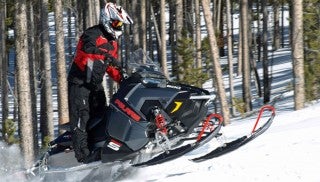
Choosing electronic gear for your sled getaways
We’ve come a long way since snowmobile adventurers relied on trailside campfires to get warm and required battling wind blown paper maps to find their way on unfamiliar trails. That was our grandfather’s snowmobiling. Today we hit a toggle switch for hand and thumb warmth or plug-in foot warmers and electric face shields to keep warm and see clearly. And those old, clumsy paper maps? Now we can find our way with a Bluetooth app on our phones or use a touch screen GPS to route our sleds through unfamiliar terrain. Plus, we can retain instant memories of our trip on a sleek handlebar-mounted video recorder. Or, we can instantly message other riders as to our exact location so they can join up with us and share our ride.
Grandpa may be flummoxed by new technologies, but rest assured that his grandkids are not as they bring the latest high tech into their everyday snowmobiling. Today’s snowmobile action is enhanced with Plug & Play technologies.
GPS
The advent of snowmobile-specific GPS products is one of the biggest advancements in snowmobiling and is just now starting to change the way we ride. Polaris takes advantage of the latest hardware and software trends to offer an all-digital interactive display on select 2015 models or as an accessory component. Think of this as being like the new U-Connect systems on automobiles. The Polaris unit features a high-resolution 4.3-inch color LCD display that can offer the expected speed and distance data, but also can enable GPS mapping capability and Bluetooth functions for your modern cell phone.
While the Polaris system is the first of its kind, you will also find that GPS icon Garmin has teamed its Montana 650 GPS with a Ski-Doo Mount Kit that gives you virtual go-anywhere knowledge of local terrain. Designed for REV-XM and REV-XP chassis sleds, Ski-Doo’s kit integrates plug and play connectivity with a tough, proven GPS system that offers a bright four-inch sunlight-readable color display. The Montana 650 features a five-megapixel camera that automatically geo-tags each image so you can relive each trailside moment.
GPS-Equipped Goggles from Zeal Optics
If you want, you can even convert paper maps into downloadable files to keep your trip logs up to date. This could be very important as local trails change from season to season as clubs and landowners often make route changes that might not show up on other digital media.
Garmin’s Montana 650, with its one-of-a-kind dual battery system, provides the option of using a rechargeable lithium-ion pack or more readily available AA batteries. You can find more information about the Ski-Doo Montana GPS kit at the online Ski-Doo store.
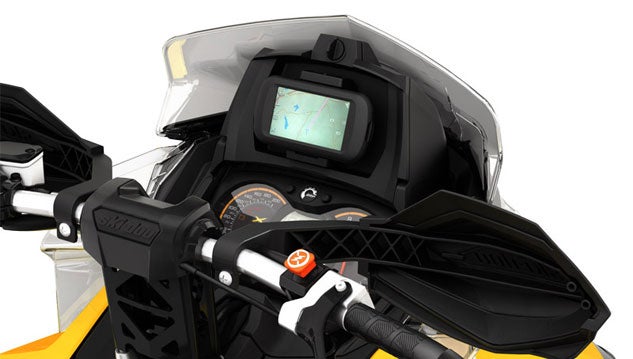 GPS icon Garmin has teamed its Montana GPS with a Ski-Doo Mount Kit that gives you virtual go-anywhere knowledge of the local terrain.
GPS icon Garmin has teamed its Montana GPS with a Ski-Doo Mount Kit that gives you virtual go-anywhere knowledge of the local terrain.Another alternative would be Garmin’s Rino 530HCx GPS unit, which combines a highly sensitive GPS with the added benefits of a built-in radio. This unit brings many features to the off-trail adventurer as it also incorporates a barometric altimeter, electronic compass, weather radio function, transmitting power of five watts and microSD card slot for additional capacity.
Of course, GPS units need their own reference points and that’s why you’ll want to take advantage of downloadable maps like those now available from the Minnesota DNR, whose site provides GPS users with a downloadable Garmin background map containing Minnesota Snowmobile Trails. You’ll be able to access information about state trails, trails within state parks, state forests and other state-owned lands, as well as snowmobile trails funded through the Grant-In-Aid snowmobile system. This information features annual data updated from the state’s many snowmobile clubs.
Currently the downloadable information is limited to Garmin, but the DNR is working to include file formats for both Lowrance and Magellan devices.
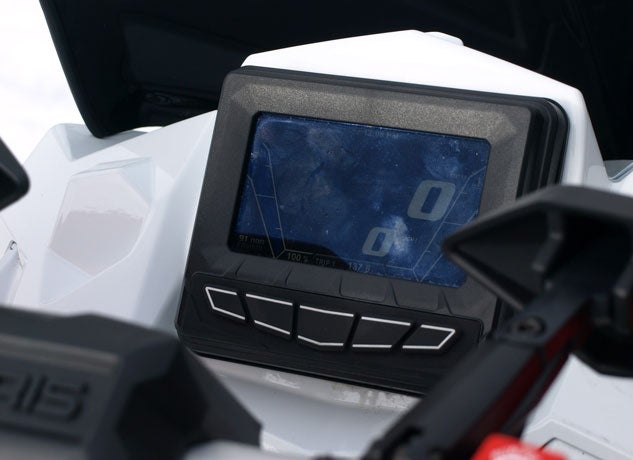 Select 2015 Polaris models will come equipped with the new interactive display that offers on-trail GPS mapping and interacts with your Bluetooth cell phone like the U-Connect system in some automobiles.
Select 2015 Polaris models will come equipped with the new interactive display that offers on-trail GPS mapping and interacts with your Bluetooth cell phone like the U-Connect system in some automobiles.If you don’t get the Ski-Doo specific mounting kit or buy a new Polaris with its interactive display, you can still utilize various other GPS units and safely stow them on special handlebar gear bags like the one from Coldwave. Retailing for approximately US$75, the Coldwave handlebar bag system is compact and designed to fit virtually any sled. It offers a large main storage compartment. Constructed of rugged Cordura materials, there are multiple side pockets and a top pocket specifically designed to accommodate a GPS unit.
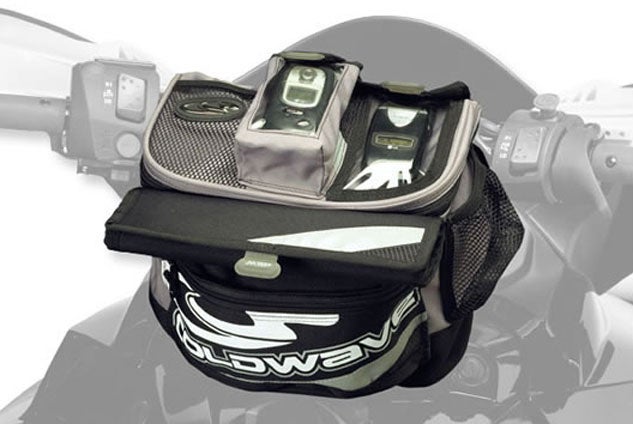 Since many snowmobiles may not be “GPS-friendly,” Cold wave devised a special handlebar-mounted bag to accommodate a GPS placement. (Photo courtesy of Coldwave)
Since many snowmobiles may not be “GPS-friendly,” Cold wave devised a special handlebar-mounted bag to accommodate a GPS placement. (Photo courtesy of Coldwave)Video
If you watch YouTube videos of snowmobiling action, chances are that those productions were captured on a GoPro Camera. The latest version is the GoPro Hero3+ Black Edition, which sells for about US$400. If you are new to GoPro, the company’s website lets you shop for gear by activity. Simply “click” the SNOWMOBILING tag and you’ll be directed to a GoPro Snowmobiling Bundle, which offers options in cameras, a selection of mounts and even memory cards.
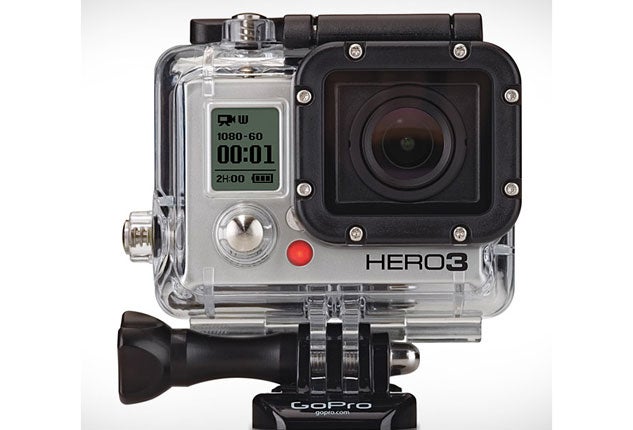 Most on-sled action is the direct result of a rider using a GoPro camera. The GoPro Hero3+, the newest model, is 20 percent lighter than previous models. (Photo courtesy of GoPro)
Most on-sled action is the direct result of a rider using a GoPro camera. The GoPro Hero3+, the newest model, is 20 percent lighter than previous models. (Photo courtesy of GoPro)The GoPro mantra of “Wear it. Mount it. Love it.” means more as the latest cameras have been scaled down to be 20 percent lighter than previous versions. Yet you get more advanced features that include a new automatic low light mode, faster action photo capture mode and improved audio quality.
While there are competitors to the GoPro, it remains the action camera of choice for serious snowmobile “heroes.”
Plug Into Clarity, Warmth & Communication
Those ubiquitous 12-volt plug receivers seen on most new snowmobile models offer snowmobilers the advantage of wearing an electrically heated face shield, such as the one that comes standard on Scorpion’s EXO 900 or EXO 400 Snow Ready helmets. These designs provide fog-free vision via an extension cord that connects the shield to the sled’s power. You can check out these two Scorpion helmets with electric face shields at the company’s shopping site.
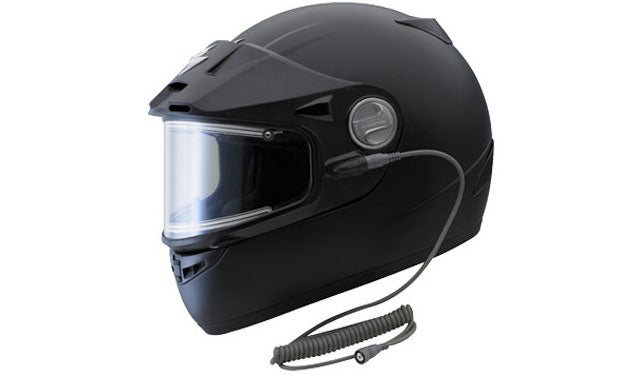 Various helmet brands, including Scorpion’s EXO 400 Snow Ready helmet, offer plug-in electric grid shields that generally retail in the US$210 to US$330 price range. (Image courtesy of Scorpion Helmets)
Various helmet brands, including Scorpion’s EXO 400 Snow Ready helmet, offer plug-in electric grid shields that generally retail in the US$210 to US$330 price range. (Image courtesy of Scorpion Helmets)Various helmet brands, including HJC, also offer electric grid shields and will generally retail in the US$210 to US$330 price range. All will give you clear riding visibility and easy plug and play adaptability.
We modern riders can also benefit from plug-in boot liners, electric vests and gloves from companies ranging from the Big Four snowmobile manufacturers – Arctic Cat, Ski-Doo, Polaris and Yamaha – to specialty companies like Gerbings, a company well known to cold weather motorcycle riders.
Considering that snowmobiling is a social sport, it stands to reason that other plug and play electronics a snowmobiler might want would be a helmet-to-helmet communicator. There are a number of good on-trail communicators available, but one that proved itself in the deep snows of the Rocky Mountains is Cardo Systems’ wireless Scala Rider G4 PowerSet. It features corded rather than boom microphones and its intercom system was specifically designed for snowmobile riders.
Scala Rider G4 PowerSet Review
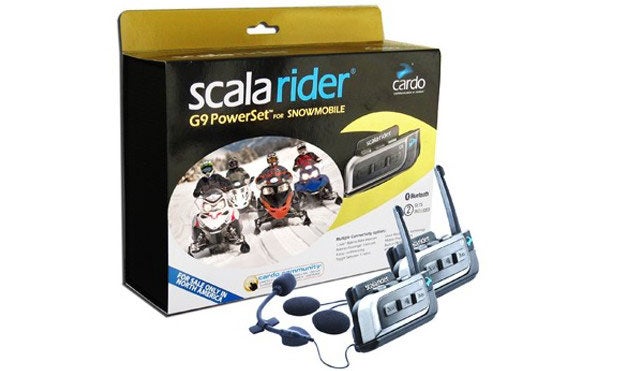 Consisting of a set of two pre-paired Bluetooth intercom devices, the corded Scala Rider G4 PowerSet comes with an ultra-thin corded microphone that clamps on to the helmet. (Image courtesy of Cardo Systems)
Consisting of a set of two pre-paired Bluetooth intercom devices, the corded Scala Rider G4 PowerSet comes with an ultra-thin corded microphone that clamps on to the helmet. (Image courtesy of Cardo Systems)Consisting of a set of two pre-paired Bluetooth intercom devices, the corded Scala Rider G4 PowerSet comes with an ultra-thin corded microphone that clamps onto the helmet. The G4 communication allows simultaneous conversations without the delay common to older “walkie talkie” systems. Besides this intercom between sleds, riders also can speak wirelessly via a Bluetooth phone.
The latest in the Scala lineup is the G9 PowerSet that provides crystal clear intercom communication at distances of up to one mile between riders. To achieve hands-free operation you can “pair” two mobile phones simultaneously via the system’s two Bluetooth channels.



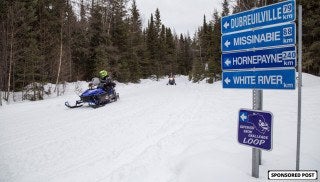
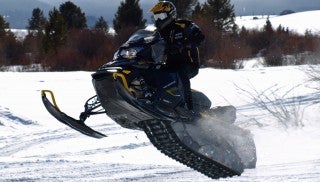
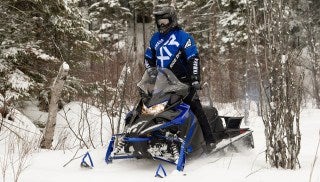


 Your Privacy Choices
Your Privacy Choices